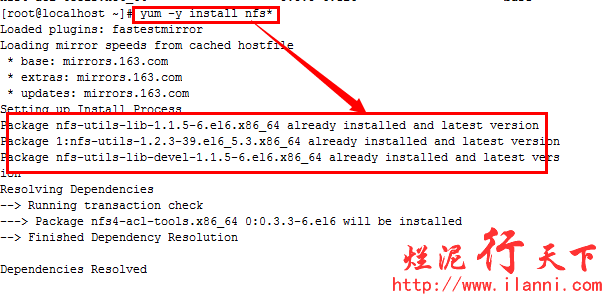I installed CentOS7 on Virtualbox. I have installed port map using sudo yum install portmap and then tried to enable it with service rpcbind start however I can not enable the service. I tried rebooting and entering following codes but nothing happened: [hadi@localhost ~]$ systemctl enable rpcbind.socket [hadi@localhost ~]$ systemctl restart rpcbind.service Job for rpcbind.service failed because the control process exited with error code. See 'systemctl status rpcbind.service' and 'journalctl -xe' for details. I appreciate your suggestions if you need the status of rpcbind: Redirecting to /bin/systemctl status -l rpcbind.service ● rpcbind.service - RPC bind service Loaded: loaded (/usr/lib/systemd/system/rpcbind.service; indirect; vendor preset: enabled) Active: failed (Result: exit-code) since Sat 2017-06-17 18:32:07 IRDT; 32s ago Process: 4382 ExecStart=/sbin/rpcbind -w $RPCBIND_ARGS (code=exited, status=127) Jun 17 18:32:07 localhost.localdomain systemd[1]: Starting RPC bind service. Jun 17 18:32:07 localhost.localdomain rpcbind[4382]: /sbin/rpcbind: symbol lookup error: /sbin/rpcbind: undefined symbol: libtirpc_set_debug Jun 17 18:32:07 localhost.localdomain systemd[1]: rpcbind.service: control process exited, code=exited status=127 Jun 17 18:32:07 localhost.localdomain systemd[1]: Failed to start RPC bind service.

Jun 17 18:32:07 localhost.localdomain systemd[1]: Unit rpcbind.service entered failed state. Jun 17 18:32:07 localhost.localdomain systemd[1]: rpcbind.service failed.
To see mount information for an NFS server (rpc portmap service is required), enter: # showmount -e # showmount -d # showmount -a server.ip. A Note About NFSv4 Services. The NFSv4 server works without the portmap, rpc.lockd, and rpc.statd daemons. The rpc.mountd daemon is still required on the server. The NFSv4 client works without rpc.lockd and rpc.statd.
This tutorial exists for these OS versions • CentOS 7.2 • • On this page • • • • • • • • This guide explains how to set up an NFS server and an NFS client on CentOS 7. NFS stands for Network File System; through NFS, a client can access (read, write) a remote share on an NFS server as if it was on the local hard disk. I'll use a CentOS 7.2 minimal server as basis for the installation. 1 Preliminary Note I'm using two CentOS systems here: • NFS Server: server.example.com, IP address: 192.168.1. Game Vigilante 8 For Pc. 100 • NFS Client: client.example.com, IP address: 192.168.1.101 I will use the nano editor in this tutorial to edit configuration files. Nano can be installed like this. Yum -y install nano 2 Configure the Firewall I recommend having a firewall installed. If you do not have firewalld installed yet and want to use a firewall, then install it with these commands.
Yum -y install firewalld start the firewall and enable it to be started at boot time. Systemctl start firewalld.service systemctl enable firewalld.service Next, open the SSH and NFS ports to ensure that you will be able to connect to the server by SSH for admin purposes and by NFS from our NFS client. Firewall-cmd --permanent --zone=public --add-service=ssh firewall-cmd --permanent --zone=public --add-service=nfs firewall-cmd --reload 3 Installing NFS server: On the NFS server we run: yum -y install nfs-utils Then enable and start the nfs server service.
Systemctl enable nfs-server.service systemctl start nfs-server.service client: On the client, we can install NFS as follows (this is actually the same as on the server): yum install nfs-utils 4 Exporting Directories on the Server server: I'd like to make the directories /home and /var/nfs accessible to the client; therefore we must 'export' them on the server. When a client accesses an NFS share, this normally happens as the user nfsnobody. Usually the /home directory isn't owned by nfsnobody (and I don't recommend to change its ownership to nfsnobody!), and because we want to read and write on /home, we tell NFS that accesses should be made as root (if our /home share was read-only, this wouldn't be necessary). The /var/nfs directory doesn't exist, so we can create it and change its ownership to the user and group nfsnobody. Mkdir /var/nfs chown nfsnobody:nfsnobody /var/nfs chmod 755 /var/nfs Now we must modify /etc/exports where we 'export' our NFS shares. We specify /home and /var/nfs as NFS shares and tell NFS to make accesses to /home as root (to learn more about /etc/exports, its format and available options, take a look at man 5 exports ) nano /etc/exports /home 192.168.1.101(rw,sync,no_root_squash,no_subtree_check) /var/nfs 192.168.1.101(rw,sync,no_subtree_check) (The no_root_squash option makes that /home will be accessed as root.) Whenever we modify /etc/exports, we must run: exportfs -a afterwards, to make the changes effective.